
Damselflies are insects of the suborder Zygoptera in the order Odonata. They are similar to dragonflies, which constitute the other odonatan suborder, Anisoptera, but are smaller and have slimmer bodies. Most species fold the wings along the body when at rest, unlike dragonflies which hold the wings flat and away from the body. An ancient group, damselflies have existed since at least the Lower Permian, and are found on every continent except Antarctica.

Enallagma cyathigerum is a species found mainly between latitudes 40°N and 72°N; It is widely distributed in the Palearctic, and the Nearctic species Enallagma annexum was at one time considered to be synonymous with it. The species can reach a length of 32 to 35 mm. It is common in many different countries including Russia, Europe and South Korea. Damselflies are an important link between the health of the aquatic ecosystem and its response to climate change.

The blue-tailed damselfly or common bluetail is a damselfly, belonging to the family Coenagrionidae.

Ischnura senegalensis, also known variously as common bluetail, marsh bluetail, ubiquitous bluetail, African bluetail, and Senegal golden dartlet, is a widespread damselfly of the family Coenagrionidae. It is native from Africa, through the Middle East, to southern and eastern Asia.
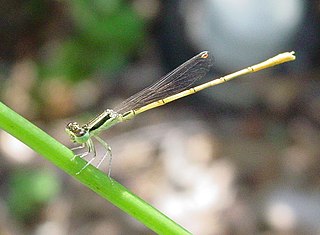
The citrine forktail is a damselfly of the family Coenagrionidae.

Somatochlora, or the striped emeralds, is a genus of dragonflies in the family Corduliidae with 42 described species found across the Northern Hemisphere.
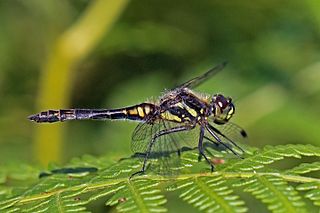
Sympetrum danae, the black darter or black meadowhawk is a dragonfly found in northern Europe, Asia, and North America. At about 30 mm (1.2 in) long, it is Britain's smallest resident dragonfly. It is a very active late summer insect typical of heathland and moorland bog pools.

Ischnura aurora, golden dartlet, also known as the aurora bluetail, is a species of damselfly in the family Coenagrionidae.
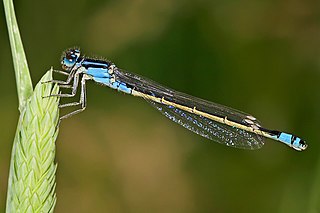
Ischnura is a genus of damselflies known as blue tails in the family Coenagrionidae. Forktails are distributed worldwide, including various oceanic islands. The males have a forked projection at the tip of the abdomen which gives the group their common name.

The scarce blue-tailed damselfly or small bluetail is a member of the damselfly family Coenagrionidae.

The wildlife of Cyprus includes its flora and fauna and their natural habitats. Cyprus has a rich flora and a diverse fauna albeit with relatively few mammals. Like most modern countries, the natural habitats in Cyprus have been steadily disappearing, currently retaining only 20% of its original habitat due to rapid urbanization, usage of forests for commercial purposes, tourism and various other reasons. One of the unique features of Cyprus' habitats is the wild and sharp differences in elevations and habitats in different parts of the island as well as different climate conditions, all of which supply a diverse habitat for a unique array of fauna and flora.. Terra Cypria was established as a trust in 1992 to conserve the Cypriot environment and its biodiversity.
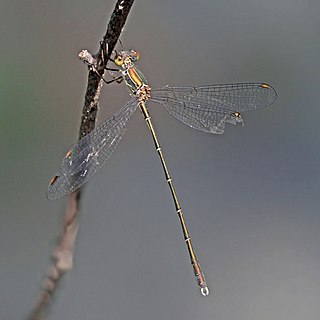
Chalcolestes parvidens, formerly Lestes parvidens, is a damselfly of the family Lestidae. It has a metallic green body and at rest it holds its wings away from its body. Its common name in English is the eastern willow spreadwing.

Esme longistyla is damselfly in the family Platycnemididae. It is commonly known as the Nilgiri bambootail. It is endemic to Western Ghats in India.

Eastern forktail is a member of the damselfly family Coenagrionidae.

Onychogomphus forcipatus, the small pincertail or green-eyed hook-tailed dragonfly, is a species of dragonflies belonging to the family Gomphidae.
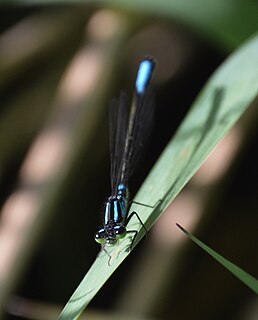
Ischnura erratica, the swift forktail, is a species of damselfly in the family Coenagrionidae. It is native to the Pacific Northwest, ranging from British Columbia to northern California.

Ischnura rubilio, western golden dartlet, is a species of damselfly in the family Coenagrionidae. It is found in Indian subcontinent and Iran.
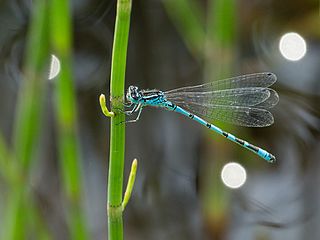
Coenagrion ornatum, or, the ornate bluet, is a species of damselfly from the family Coenagrionidae distributed across a large part of Europe and Western Asia.

Epallage fatime, the Oriental damselfly, is a damselfly (Zygoptera) from the family of the Euphaeidae.





















